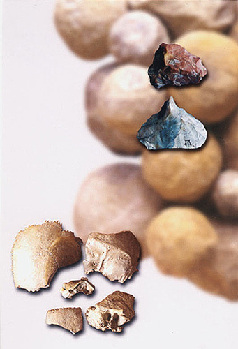Archaeological sites from the Early to the Late Paleolithic Age
Location: InNihewanBasinon the border ofHebeiandShanxiprovinces
Period: 1,000,000-10,000 BP
Excavated from 1965 to the present
Significance: The finds are of great importance to the study of stone implement culture inChinaandEast Asia. In addition, human fossils unearthed at Xujiayao have supplied rich material objects to the study of the evolution of Homo sapiens inChina.
 Introduction
Introduction
 |
| Fossil cranium of the Xujiayao Man: (bottom); Stone scraper: tool (up, length 2.9 cm); Stone borer: tool (mid, length 3.2 cm) |
The Nihewan Basin is similar to the Olduvai Gorge of East Africa in its palaeo-environmental conditions and abundant archaeological materials recovered from Early Pleistocene deposits. The Nihewan basin was formed from a dried-out
ArchaicLake, which existed 25,000 years ago.
In the late 1970s, the first archaeological site, Xiaochangliang, was identified and dated on the basis of palaeo-magnetism to before 1 million years ago. In the 1980s and 1990s, dozens of Paleolithic sites were identified such as Hutouliang, Xujiayao, Houjiayao and Donggutuo, although few have been fully investigated. These discoveries suggest that over 1 million years ago, our remote ancestors arrived here, probably fromAfrica, to make a living at this lakeshore land. There are also a large number of Paleolithic cultural relics and representative animal fossils of the Fourth Ice Age.
The archaeological sites were located on the present-day hilltop at the southern ridges of the basin, a beach in ancient times. Although the topographic features present many gullies on the Quaternary loess formation, it can be imagined that the area was most likely a broad open flat waterfront visited frequently by these early hominids. They may have lived on scavenging from kills left by carnivores like hyenas. Therefore these archaeological sites may well likely represent temporary occupations of such "picnic" activities.
